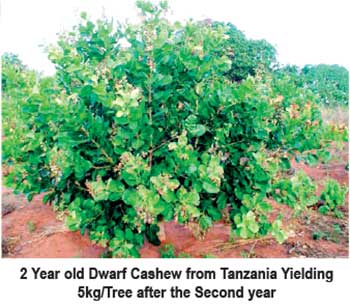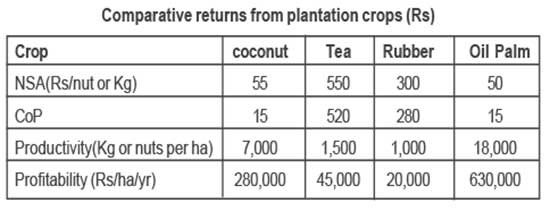Policy blunders in agriculture-By Dr PARAKRAMA WAIDYANATHA

Blunders in state agriculture policy making has been rampant, and the need for our leaders to consult experts in policy making cannot be overstated. Let us dwell into some of the blunders. The ‘Yahapalana’ regime banned glyphosate herbicide use, but yielded when alternative herbicides used in tea had residue levels above allowable limits in the made tea, leading to serious tea marketing problems. Consequently, the re-use of glyphosate in tea and rubber only, but not for other crops, was approved! Rubber industry never asked for it because it is not critically needed, as weeds are essentially managed in rubber plantations with cover crops. On the other hand, coconut plantations have the serious problem of managing the highly competitive grasses, and research has established that their control with glyphosate yielded 38% more as against only 18% when grasses were slashed.
Toxin-free agriculture project collapse
Then the Yahapalana regime proceeded pell-mell from its commencement in 2015 promoting organic farming and overlooking conventional farming. The Strategic Enterprises Management Agency (SEMA) was totally transformed into an institute for promoting the so-called ‘toxin –free’ farming activities. The chief visionary of the programme was, of course, the then President. Neither the Ministry of Agriculture nor the Department of Agriculture were consulted, but compelled to carry out various short-sighted, organic farming- related activities. The officials meekly yielded. Ven Ratana thero, M.P, who was virtually the second in command in the ill-fated project, produced his own fertilizer named ‘Pivithuru Pohora’., running a factory in Mahaweli System B!
A team of senior retired agricultural scientists, who visited the site to examine the performance of this ‘wonder fertilizer’, was confidentially told by the farmers that the paddy crop turned yellow following application of Pivituru Pohora, a clear sign of nitrogen deficiency, and they then secretively applied urea! Why ‘secretively’, because they were selling the produce to the daughter of a top politician in Polonnaruwa as ‘organic paddy’, at Rs 10/kg higher than the conventional paddy! The ‘Pivituru Pohora’ was obviously sold to farmers without adequate testing: the Department of Agriculture trials at Aralaganwila did not show response to that fertilizer!
The SEMA toxin free project too was a total failure and was closed down in 2019 as a consequence!
New government making
the same blunder

The new government has sadly failed to learn a lesson from the failure of the organic agriculture and associated pursuits of the previous regime! The new President, in his policy statement, announced his commitment to make the country totally organic in the next ten years! And the Governor of the Eastern Province, overwhelmed with organic farming, is compelling the officials to only promote it in the Province!
The whole world has yet only 2% in organic farming of which 66% is in pastures (for the rich to eat organic beef steaks!), only the balance being in other crops. Organic agriculture is expanding by only at 10% of its farm extent annually, implying that it will take at least 35 years for the entire world to be totally in it! Will it ever happen? The whole world moved away from organic farming from about the 1820s because it could not produce the global food demand. Vaclav Smil, distinguished Professor, University of Manitoba, for example, in 1987, estimated that 40% of today’s population is alive, thanks to the Haber-Bosch process of synthesizing ammonia.. However, organic farming may be promoted as much as possible, as organic food fetches a premium price giving good incomes to the farmer and , in any case, adding organic matter to our soils is highly beneficial. Total banning of agrochemicals is, however, never attainable! The detrimental issue is its excessive use. What is critically needed is to educate the farmers in judicious use of agrochemicals. No government in the recent past has addressed this vital issue effectively.
The oil palm fiasco
The plantation companies wanted to expand its cultivation to 20,000ha from its current 11,000 ha replacing some unproductive rubber with it. The Yahapalana Cabinet approved it several years ago, following which the plantations set up nurseries with imported high yielding hybrid seeds at a cost of some Rs500 million. The then President, however, went back on the Cabinet decision suspending its cultivation expansion! It would appear that the presidential decision was on the basis of a highly flawed report by the Central Environmental Authority, which has been totally rejected by the majority of scientists conversant in the matter, including the Coconut Research Institute, the organization mandated for oil palm research.
The outcry of villagers living close to oil palm plantations in the south was that oil palm dries up the soil and water bodies in their villages! Scientific evidence does not at all support this contention. The research evidence is that per unit area of land rubber and oil palm evapo-transpiration rates are comparable, and more importantly, whereas the water footprint, that is, the volume of water required to produce one metric ton of raw rubber is 32,410 cubic metres, that needed to make a ton of crude palm oil is only 19,148! In any case, the responsible institutions should have carried out a comprehensive hydrological study, comparing an exclusively oil palm area vis a vis a totally rubber area, to convince the villagers and policy makers. The politicians totally backed the villagers’ protests, obviously because of the then pending general elections. And one government politician in the south even proceeded to fell an oil palm tree in the wilderness, with the media coverage, to impress the villagers, just before the election! Even the Minister of Plantation Industries, a southerner has apparently meekly heeded the villagers’ objections. Being a qualified medical doctor, he should have gone on scientific evidence and correctly briefed the people and the President too.
President Gotabaya Rajapaksa has banned further oil palm cultivation in Sri Lanka several months ago. It is obvious that he has been totally misinformed on the subject. The benefits of oil palm are huge. It is the number one vegetable oil in the world, producing 35% of the global vegetable oil demand from 19 million hectares as against the number two, soybean, which produces only 28% of the oil from 147 million hectares, because of its very low productivity being only about a tenth of oil palm. Coconut yields only one fifth that of oil palm. Over the last 50 years, its production globally has increased 30 fold from less than 2.5 million MT in 1970 to over 70 million. More than a third of the global oil palm plantations are in the hands of small farmers, especially in Malaysia and Indonesia, where many are shifting from other crops such as rubber to oil palm because of the much higher returns. The Table below shows that the returns from oil palm in the local scenario is far more that of the other three plantation crops.
Palm oil and health

Some argue that palm oil has health risks. In fact, its cholesterol elevating saturated fat (palmitic acid) content is only about 45%, whereas that of coconut oil is over 70%. However, both these oils have a number of other health benefits. Palm oil has the advantage of having 39% linoleic acid, a monounsaturated fatty acid, (the same principal fatty acid as in olive oil), that lowers the bad cholesterol but does not affect the good cholesterol.
However, the European Food Safety Authority (EFSA) pronounced a few years back that consumption of palm oil in moderation has no cancer risk. Further, a more recent, comprehensive review in the Journal, Nutrients (2019), 10 reputed scientists concluded that there is no direct or indirect evidence of palm oil consumption being associated with cancer in human beings.
It is unfortunate that the President did not consult the Coconut Research Institute, the organization mandated for R & D on oil palm, before making this vitally important national decision. Further, a team of sixteen senior scientists including eleven academics(professors) well versed in the subject, wrote to the President recently seeking an appointment to brief him on the subject, but, was told by his office that already a policy decision has been made on the matter! Must not faulty policies be rectified?
Expand coconut in the dry zone for oil?
Further, the government has now apparently rushed into a decision to plant up 50,000 ha coconut in the dry zone under drip irrigation for increasing oil production. It would appear that coconut is already grown in nearly all areas in the dry zone suitable for it. Is the water available during the droughts for irrigation?. Further, there is strong research evidence that with global warming and temperatures shooting up during droughts, especially in the months of April and August, coconut pollen germination is inhibited in the dry zone, causing poor fruit set. Have these factors been taken into consideration. Ideally the crop for the balance dry zone appears to be cashew, which can bring in more income if grown scientifically than coconut. We do not have highly productive cashew dwarf hybrids of the type in the picture.
They should be secured from other countries perhaps through a germplasm exchange programme. However, it is reported that the University of Wayamba has recently produced hybrids with a yield potential of 13-15kg/tree/yr after the 4th year and at least they should be actively promoted among growers.
Alternative land for oil palm
If the government is reluctant to grow oil palm in the wet zone rubber lands, an alternative is to use the uncultivated paddy fields which amount about 60,000 ha of which nearly 50,000 are in the wet zone. The appropriate ill-drained soils should be drained for the purpose and oil palm grown on raised beds as seen in the picture, being done for coconut in Thailand. The excess water can be retained in ponds at the bottom of the catena for fish culture. Such cultivation could provide our entire vegetable oil demand, saving some Rs 40 billion spent on import of palm oil. Alternative crops for these lands are of course coconut, vegetables and horticultural crops. The Agrarian Development Act of 2000 may need to be amended for the purpose.
Learning from India
We have lessons to learn from India both on oil palm and policy making! India is targeting cultivation of 2 million hectares of oil palm by 2030, replacing much of its nine seasonal oil crops from irrigated lands because of their poor yields (usually less than 1ton/ha/season). Already over 400,000 ha have been planted to it . India has a huge vegetable oil import bill much of it being for palm oil!
The decision to expand oil palm cultivation was made by the Planning Commission of India after extensive deliberations by the experts in the Commission. The Commission was first set up during the Nehru regime in the 1950s, and the present Prime Minister has changed its name to the National Technology Commission (Niti Aayog in Hindi). Its functions amongst others are creation of innovation and knowledge, and advising the government on major developmental policy issues. Sri Lanka should necessarily follow suit and have such a commission so that leaders act on the advice of experts, and not on misinformation of ‘Dicks, Toms and Harrys’!








No Comments